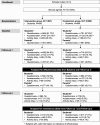Kids Out; evaluation of a brief multimodal cluster randomized intervention integrated in health education lessons to increase physical activity and reduce sedentary behavior among eighth graders
- PMID: 30995905
- PMCID: PMC6472104
- DOI: 10.1186/s12889-019-6737-x
Kids Out; evaluation of a brief multimodal cluster randomized intervention integrated in health education lessons to increase physical activity and reduce sedentary behavior among eighth graders
Abstract
Background: Most Finnish adolescents are not sufficiently physically active. Health education (HE) provides beneficial starting point for physical activity (PA) promotion in schools. This study evaluates an intervention integrated into three HE lessons to increase PA and reduce sedentary behavior (SB) among eighth graders.
Methods: All public secondary schools in Tampere, Finland participated and were randomized to intervention (INT, n = 7) and comparison group (COM, n = 7). In INT (690 students, 36 classes) the teachers (n = 14) implemented behavioral theory-driven content during three HE lessons. In COM (860 students, 41 classes) the teachers (n = 14) carried out standard lessons. The evaluation was based on RE-AIM: Effectiveness was assessed from baseline to 4 weeks (Follow-up 1) and Maintenance from 4 weeks to 7 months (Follow-up 2) with change in students' PA and SB and related psychosocial and parental factors. Methods included questionnaire, accelerometer and activity diary. Linear mixed models with baseline adjustments and random effect correction were used to compare the difference in change between INT and COM. Data on Reach, Adoption and Implementation were collected during the process.
Results: Intervention effects were only seen in the self-reported data favoring INT in the weekly number of days with at least 1 h of brisk leisure PA (0.3 [95%CI 0.1 to 0.6]), proportion of students meeting PA recommendations (4.1 [95%CI 2.5 to 5.7]), proportion of students reporting that their family sets limitations for screen time (5.4 [95%CI 3.3 to 7.4]) and in the number of days on which the students intended to do leisure PA in the following week (0.3 [95%CI 0.1 to 0.6]). The effects on PA were still beneficial for INT at Follow-up 2. The intervention reached 96% of the students, was adopted in all 7 schools and was implemented by 13/14 teachers in 35/36 classes.
Conclusions: The intervention was feasible and had small favorable effects on students' self-reported PA, intention to do PA and family norm in screen time. The effects on PA persisted until Follow-up 2. It is likely that for greater impacts the HE lessons should have been supported with other actions without compromising feasibility.
Trial registration: NCT01633918 (June 27th, 2012).
Keywords: Adolescents; Health education; Health promotion; Internet; Lessons; RE-AIM; School.
Conflict of interest statement
Ethics approval and consent to participate
The study plan was approved by the Ethics Committee of the Tampere Region, under the auspices of University of Tampere, Human Sciences (
Consent for publication
Not applicable.
Competing interests
The authors declare that they have no competing interests.
Publisher’s Note
Springer Nature remains neutral with regard to jurisdictional claims in published maps and institutional affiliations.
References
-
- Van Hecke L, Loyen A, Verloigne M, van der Ploeg HP, Lakerveld J, Johannes Brug J, De Bourdeaudhuij I, Ekelund U, Donnelly A, Hendriksen I, Deforche B, and on behalf of the DEDIPAC consortium. Variation in population levels of physical activity in European children and adolescents according to cross-European studies: a systematic literature review within DEDIPAC. Int J Behav Nutr Phys Act. 2016. 10.1186/s12966-016-0396-4. - PMC - PubMed
-
- Inchley J, Currie D, Young T, Samdal O, Torsheim T, Augustson L, et al. Growing up unequal: gender and socioeconomic differences in young people’s health and well-being. International report from the 2013/2014 survey. 2016. http://www.euro.who.int/__data/assets/pdf_file/0003/303438/HSBC-No.7-Gro...
-
- Andersen LB, Riddoch C, Kriemler S, Hills A. Physical activity and cardiovascular risk factors in children. Br J Sports Med. 2011. 10.1136/bjsports-2011-090333. - PubMed
-
- Biddle SJH, Asare M. Physical activity and mental health in children and adolescents: a review of reviews. Br J Sports Med. 2011. 10.1136/886bjsports-2011-090185. - PubMed
-
- Pälve KS, Pahkala K, Magnussen CG, Koivistoinen T, Juonala M, Kähönen M, Lehtimäki T, Rönnemaa T, Viikari JSA, Raitakari OT. Association of physical activity in childhood and early adulthood with carotid artery elasticity 21 years later: the cardiovascular risk in Young Finns study. J Am Heart Assoc. 2014. 10.1161/JAHA.113.000594. - PMC - PubMed


